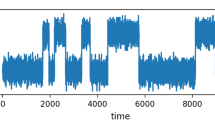Abstract
The paper treats an agent-based model with averaging dynamics to which we refer as the K-averaging model. Broadly speaking, our model can be added to the growing list of dynamics exhibiting self-organization such as the well-known Vicsek-type models (Aldana et al. in: Phys Rev Lett 98(9):095702, 2007; Aldana and Huepe in: J Stat Phys 112(1–2):135–153, 2003; Pimentel in: Phys. Rev. E 77(6):061138, 2008). In the K-averaging model, each of the N particles updates their position by averaging over K randomly selected particles with additional noise. To make the K-averaging dynamics more tractable, we first establish a propagation of chaos type result in the limit of infinite particle number (i.e. \(N \rightarrow \infty \)) using a martingale technique. Then, we prove the convergence of the limit equation toward a suitable Gaussian distribution in the sense of Wasserstein distance as well as relative entropy. We provide additional numerical simulations to illustrate both results.





Similar content being viewed by others
References
Aldana, M., Dossetti, V., Huepe, C., Kenkre, V.M., Larralde, H.: Phase transitions in systems of self-propelled agents and related network models. Phys. Rev. Lett. 98(9), 095702 (2007)
Aldana, M., Huepe, C.: Phase transitions in self-driven many-particle systems and related non-equilibrium models: a network approach. J. Stat. Phys. 112(1–2), 135–153 (2003)
Artstein, S., Ball, K., Barthe, F., Naor, A.: Solution of Shannon’s problem on the monotonicity of entropy. J. Am. Math. Soc. 17(4), 975–982 (2004)
Bakry, D., Gentil, I., Ledoux, M.: Analysis and Geometry of Markov Diffusion Operators, vol. 348. Springer, New York (2013)
Barbaro, A.B.T., Degond, P.: Phase transition and diffusion among socially interacting self-propelled agents. arXiv:1207.1926 (2012)
Baumann, F., Lorenz-Spreen, P., Sokolov, I.M., Starnini, M.: Modeling echo chambers and polarization dynamics in social networks. Phys. Rev. Lett. 124(4), 048301 (2020)
Belmonte, J.M., Thomas, G.L., Brunnet, L.G., de Almeida, R.M.C., Chaté, H.: Self-propelled particle model for cell-sorting phenomena. Phys. Rev. Lett. 100(24), 248702 (2008)
Berti, P., Pratelli, L., Rigo, P.: Almost sure weak convergence of random probability measures. Stoch. Stoch. Rep 78(2), 91–97 (2006)
Bertin, E., Droz, M., Grégoire, G.: Boltzmann and hydrodynamic description for self-propelled particles. Phys. Rev. E 74(2), 022101 (2006)
Bertin, E., Droz, M., Grégoire, G.: Hydrodynamic equations for self-propelled particles: microscopic derivation and stability analysis. J. Phys. A 42(44), 445001 (2009)
Billingsley, P.: Convergence of Probability Measures. Wiley, New York (2013)
Boissard, E., Degond, P., Motsch, S.: Trail formation based on directed pheromone deposition. J. Math. Biol. 66(6), 1267–1301 (2013)
Carlen, E., Chatelin, R., Degond, P., Wennberg, B.: Kinetic hierarchy and propagation of chaos in biological swarm models. Physica D 260, 90–111 (2013)
Chaté, H., Ginelli, F., Grégoire, G., Peruani, F., Raynaud, F.: Modeling collective motion: variations on the Vicsek model. Eur. Phys. J. B 64(3), 451–456 (2008)
Chuang, Y.-L., Dorsogna, M.R., Marthaler, D., Bertozzi, A.L., Chayes, L.S.: State transitions and the continuum limit for a 2D interacting, self-propelled particle system. Physica D 232(1), 33–47 (2007)
Cover, T.M.: Elements of Information Theory. Wiley, New York (1999)
Dai Pra, P.: Stochastic mean-field dynamics and applications to life sciences. In: International Workshop on Stochastic Dynamics Out of Equilibrium, pp. 3–27. Springer, New York (2017)
Degond, P., Frouvelle, A., Raoul, G.: Local stability of perfect alignment for a spatially homogeneous kinetic model. J. Stat. Phys. 157(1), 84–112 (2014)
Hardin, M., Lanchier, N.: Probability of consensus in spatial opinion models with confidence threshold. arXiv:1912.06746 (2019)
Hauray, M., Jabin, P.-E.: N-particles approximation of the Vlasov equations with singular potential. Arch. Ratl. Mech. Anal. 183(3), 489–524 (2007)
Jabin, P.-E., Wang, Z.: Quantitative estimates of propagation of chaos for stochastic systems with \(W^{-1,\infty }\) kernels. Invent. Math. 214(1), 523–591 (2018)
Lanchier, N., Li, H.-L.: Probability of consensus in the multivariate Deffuant model on finite connected graphs. Electr. Commun. Probab. 25, 1–12 (2020)
Liggett, T.M.: Interacting Particle Systems, vol. 276. Springer, New York (2012)
Madiman, M., Barron, A.: Generalized entropy power inequalities and monotonicity properties of information. IEEE Trans. Inform. Theory 53(7), 2317–2329 (2007)
Merle, M., Salez, J.: Cutoff for the mean-field zero-range process. Ann. Probab. 47(5), 3170–3201 (2019)
Méléard, S., Roelly-Coppoletta, S.: A propagation of chaos result for a system of particles with moderate interaction. Stoch. Process. Appl. 26, 317–332 (1987)
Motsch, S., Tadmor, E.: Heterophilious dynamics enhances consensus. SIAM Rev. 56(4), 577–621 (2014)
Naldi, G., Pareschi, L., Toscani, G.: Mathematical Modeling of Collective Behavior in Socio-Economic and Life Sciences. Springer, New York (2010)
Oelschlager, K.: A martingale approach to the law of large numbers for weakly interacting stochastic processes. Ann. Probab. 12, 458–479 (1984)
Pimentel, J.A., Aldana, M., Huepe, C., Larralde, H.: Intrinsic and extrinsic noise effects on phase transitions of network models with applications to swarming systems. Phys. Rev. E 77(6), 061138 (2008)
Popoviciu, T.: Sur les équations algébriques ayant toutes leurs racines réelles. Mathematica 9, 129–145 (1935)
Porfiri, M.: Linear analysis of the vectorial network model. IEEE Trans. Circ. Syst. II 61(1), 44–48 (2013)
Porfiri, M., Ariel, G.: On effective temperature in network models of collective behavior. Chaos 26(4), 043109 (2016)
Rezakhanlou, F., Villani, C., Golse, F.: Entropy methods for the Boltzmann equation: lectures from a special semester at the Centre Émile Borel, Institut H. Poincaré, Paris, 2001, No. 1916. Springer, New York (2008)
Sznitman, A.-S.: Topics in propagation of chaos. In: Ecole d’été de Probabilités de Saint-Flour XIX–1989, pp. 165–251. Springer, Berlin (1991)
Acknowledgements
It is a pleasure to thank my Ph.D. advisor Sébastien Motsch for his tremendous help on various portions of this manuscript, and I thank the anonymous reviewer for providing helpful comments on earlier drafts of the manuscript.
Author information
Authors and Affiliations
Corresponding author
Additional information
Communicated by Irene Giardina.
Publisher's Note
Springer Nature remains neutral with regard to jurisdictional claims in published maps and institutional affiliations.
Rights and permissions
About this article
Cite this article
Cao, F. K-Averaging Agent-Based Model: Propagation of Chaos and Convergence to Equilibrium. J Stat Phys 184, 18 (2021). https://doi.org/10.1007/s10955-021-02807-0
Received:
Accepted:
Published:
DOI: https://doi.org/10.1007/s10955-021-02807-0




